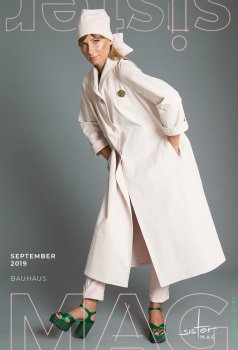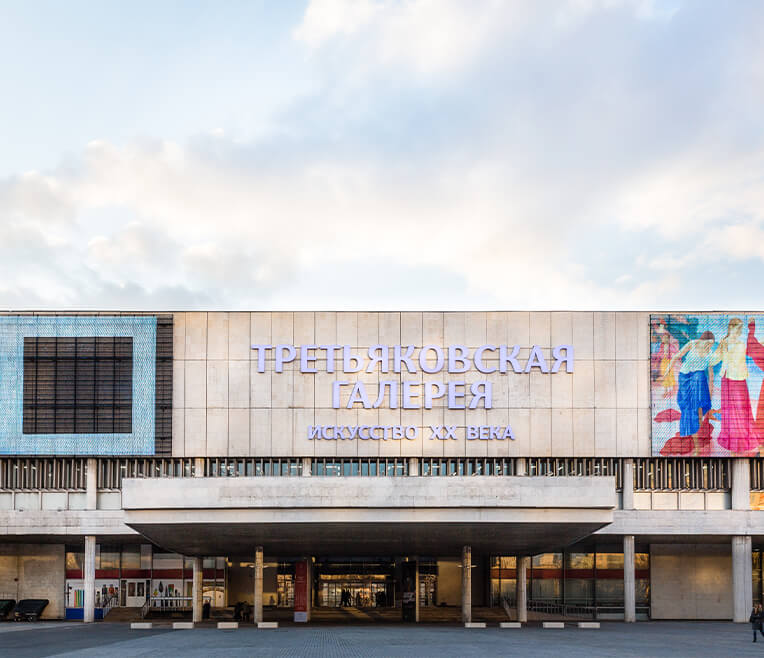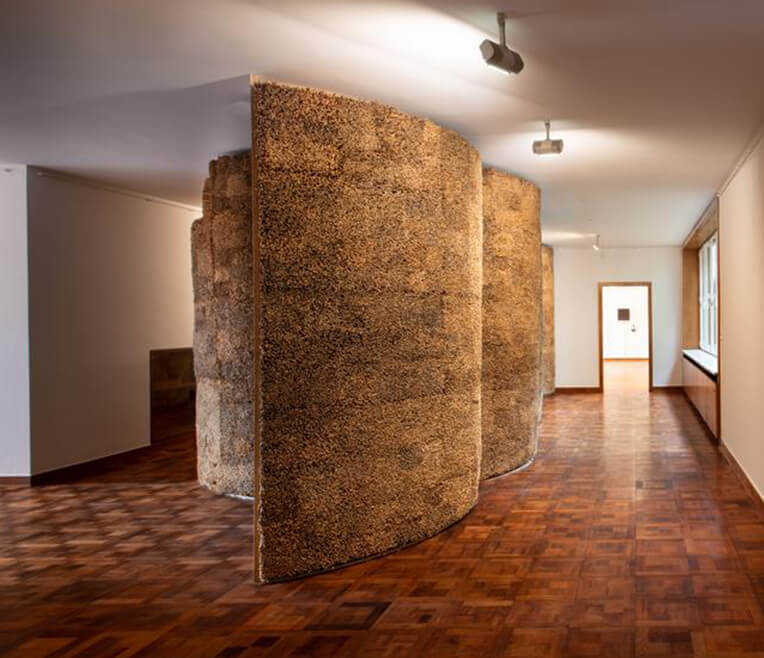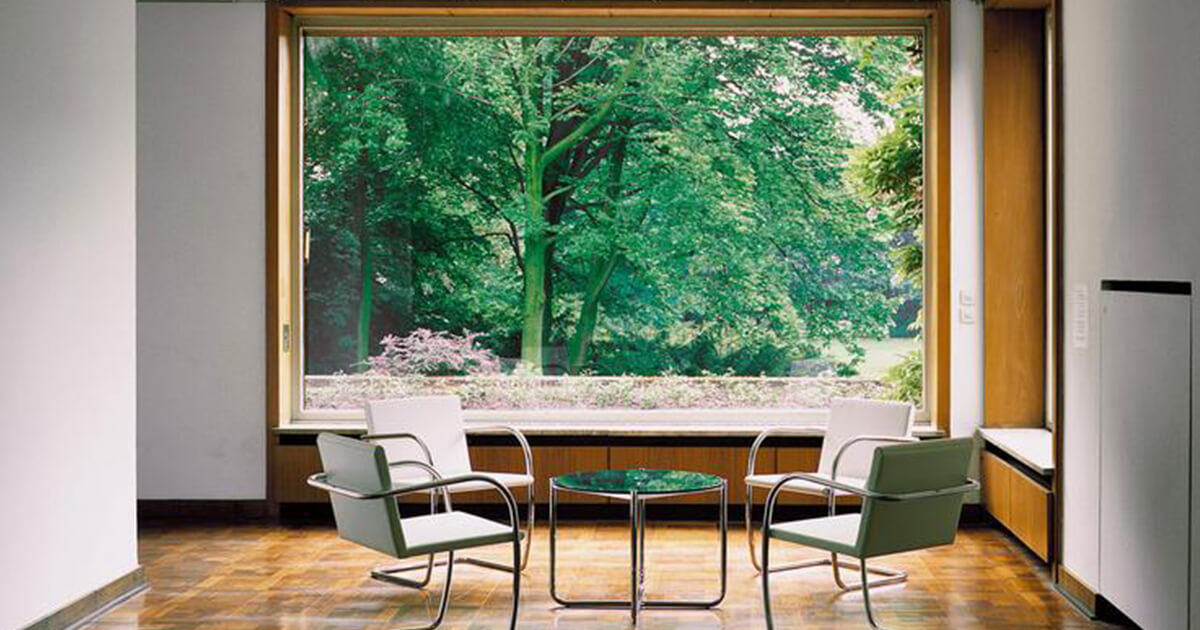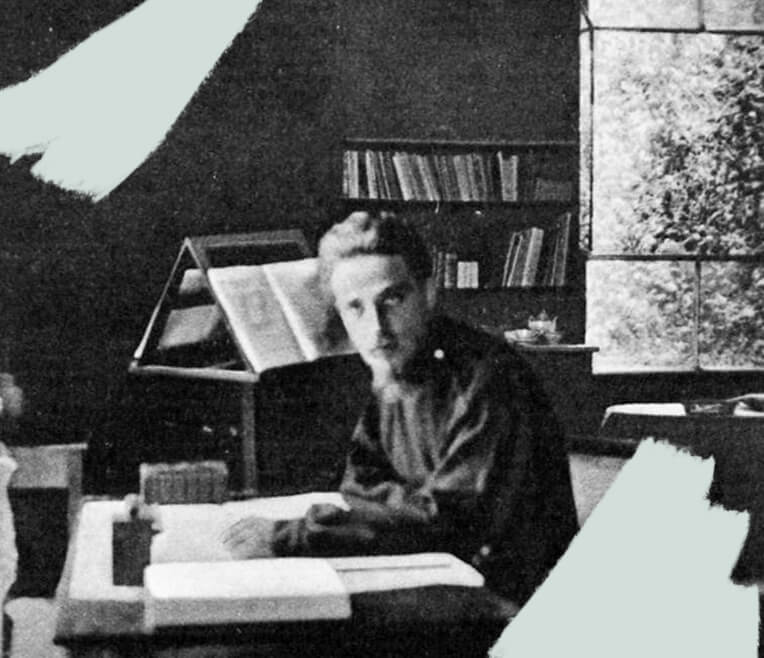
Visiting the Museen Haus Lange Haus Esters in Krefeld
It is well known by now that 2019 is the centenary anniversary of the Bauhaus art school, founded in Weimar in 1919. So, of course, it made perfect sense for sisterMAG to take on this theme in our art year. Our resident art lover, Caro, made her way to the Museen Haus Lange Haus Esters in Krefeld, two residential houses built by the last Bauhaus director, Ludwig Mies van der Rohe, at the end of the 1920s. There she visited the »Anders Wohnen. Entwürfe für Haus Lange Haus Esters« exhibition. The following sisterMAG article is an extensive exhibition feature with an interesting interview with curator Sylvia Martin as well as a field report on the experience on the work of the Bauhaus and art offerings in Krefeld.
- Text & Interview: Carolin Kralapp
Visiting the Museen Haus Lange Haus Esters in Krefeld
Exhibition: »Anders Wohnen. Entwürfe für Haus Lange Haus Esters«
We’re certainly not revealing any secrets as it is now common knowledge: 2019 is the centenary anniversary of the Bauhaus. Countless publications, exhibitions and films are currently flooding the market and paying tribute to the art school founded by Walter Gropius in Weimar in 1919. There was no question, of course, whether we would dedicate an issue to the Bauhaus in the sisterMAG art year.
Even though Krefeld is certainly not the first city that comes to mind when thinking of Bauhaus, it has stood as a breeding ground for renowned Bauhaus figures and creative expression. The Museen Haus Lange Haus Esters, two residential houses which were built at the end of the 1920s by the architectural icon and last Bauhaus director Ludwig Mies van der Rohe as private houses for the wealthy silk manufacturers Hermann Lange and Dr. Josef Esters, are a real treat for lovers of architecture and the Bauhaus aesthetic. Now open as public museums, rooms are adorned with contemporary art that reveal the spirit of »new objectivity«.
Interview with Curator Sylvia Martin (Kunstmuseen Krefeld)
1. To begin, a general question: What is behind the art museums (Kunstmuseen) in Krefeld? How are they curated, and what does the museum collection contain?
The Kunstmuseen Krefeld are the Kaiser Wilhelm Museum in the city centre, which was financed by Krefeld citizens in 1897 and was founded as one of the first public museums, and Haus Lange Haus Esters in a quiet residential quarter, which were built by Ludwig Mies van der Rohe as private houses. At KWM, various forms of art were shown at that time: arts and crafts through photography, and through classical exhibits of the fine arts. There has always been a very fruitful exchange between the museum and the artists. That remains to this day. Haus Lange was added in 1955, and Haus Esters at the end of the 1970s, which became accessible to the public in 1981. Haus Lange Haus Esters primarily function as temporary exhibition houses in the contemporary realm, while the KWM houses its own collection, which has been growing steadily since 1897. It comprises more than 18,000 pieces from the fields of applied art, painting, sculpture, graphics, photography and new media. Our director, Katia Baudin, who has been at the museum for three years, has somewhat readjusted the museum and is now once again focussed on the historical treasures. We are currently holding many exhibitions in which works from different centuries collide and invite visitors to think outside the box. The collection begins in the late Middle Ages, goes as far as contemporary art, and is continuously being expanded through acquisitions analogous to the exhibition programme. Very important positions are expressed in the art following 1945, namely those of artists such as David Reed and through larger collections by Gerhard Richter and Sigmar Polke. We are very happy to exhibit them.
2. On the occasion of the 100th anniversary of the Bauhaus, the Kunstmuseen Krefeld offer several exhibitions to mark the occasion. What do visitors expect when they come to Krefeld?
Here in Krefeld, the public encounters two remarkable buildings in the New Objectivity style: Mies van der Rohe’s Haus Lange and Haus Esters, which were built between 1927 and 1930. It is easy to discover and feel the close connection between Mies van der Rohe and Krefeld, which was brought to fruition by the builder Hermann Lange. The houses are currently showing »Anders Wohnen. Entwürfe für Haus Lange Haus Esters«, a large exhibition where future living models are thematized as a special format in three acts: Utopia, Mobility, Dystopia. A total of 14 artists and architects were invited to create something for this special place. Here we look back at the historical Bauhaus and also at our own site-specific tradition in moving towards the future. It was not meant to be a purely historical presentation, as it was also important for the Bauhaus to consider how to move forward. The exhibition »Von Albers bis Zukunft. Auf den Spuren des Bauhauses« in the Kaiser Wilhelm Museum, where masters and pupils of the Bauhaus are given a stage, is on until April 2020. For this exhibition the employees actually went on a search for traces through the museum’s collection and found, among other things, educational colour plates of the early 1920s by Wassily Kandinsky, which were stored for a long time in the archive. Those interested in architecture can also take a look at Mies van der Rohe’s only completed factory building, the VerSeid AG (Vereinigte Seidenwebereien) building in Krefeld.
3. What are the typical characteristics of Bauhaus art and architecture?
It is difficult to determine and summarize them. The characteristics are very heterogeneous. First of all, there must be functionality. This is complemented by aesthetic which is connected with the form. Playing with materials is also important. In architecture, it is the white cube that catches one’s eye. Nevertheless, the Bauhaus cannot be broken down to just a handful of stylistic characteristics. This is especially true in Bauhaus weaving or the ceramic workshops.
4. You already mentioned the architect of the Haus Lange and Haus Esters, Ludwig Mies van der Rohe – a renowned name. What should one know about this person?
Ludwig Mies van der Rohe was born in Aachen and trained by the architect Bruno Paul in Berlin. During the time before his exile in Chicago, he was particularly interested in the »open floor plan« and materials. He was interested in »architecture«, the combination of building and art, which can also be clearly seen in Haus Lange and Haus Esters. Characteristic of his architecture is the free composition of walls in forming the building as a whole. Cubes are nested into each other and yet have the character of being open towards the outside.
Basically, he was interested in the experience of space. Not so much in social building as Gropius, for example, but rather in experiencing space in connection with architecture, art and nature. The culmination of these aspects found form in the Barcelona Pavilion, built in 1928, before van der Rohe’s tenure in America. As the last director of the Bauhaus, he tried to sharpen the school’s focus on architecture and moved with the Bauhaus to Berlin. But with the increasingly difficult political situation in National Socialist Germany, which Modernism rejected, he was soon forced to close the building in 1933.
5. Circling back to the exhibition: Do you plan to purchase works from »Anders Wohnen« in Haus Lange Haus Esters for the collection? If so, which ones?
We would like to acquire works from the exhibition but are still waiting until all the works from the three acts are in the houses. The third nude, »Dystopie«, is still pending (on view from 15.09). But one or the other will stay in Krefeld. The former garden house of the Esters family, which the artist Andrea Zittel has transformed into a café for the public, has already been bought with the generous donation of a Krefeld family. We are very grateful for this!
A Field Report
Upon entering the first of the two houses by architecture icon Ludwig Mies van der Rohe, Haus Lange, you will be welcomed in the large hall – formerly the living and dining room – by works by the artists Olaf Holzapfel and Didier Fiúza Faustino.
When I enter, my gaze first wanders to Holzapfel’s »Rückgabe Reimbursement Cells – Cellulare Dialektik« (2019), a building within the building that stands out above all for its curved wall segments and half-timbered and reed materials. Walking along the work, one ends up in a small cell with rounded walls, which reveals itself as the core of the architecture. You can smell the natural material. You feel isolated from what is happening outside. It is dark and quiet. In such a confined space you are completely alone, as if you had briefly pressed pause on life and all external influences are muted. Only a small opening allows a soft glow of light to enter from the outside. Emerging from the encasing feels like a reset, a new beginning, which inspires me to explore the rest of the exhibition.
Faustino’s work also has a similar enclosing, somewhat binding effect on me. Guided by a passageway made up of sewn together aircraft ceilings, with every step one moves closer and closer towards the alarming »Global Warming« (2019), which is attached to a large window pane and opens up to a view into the green garden of Haus Lange. Artistically and strategically very well executed, it forced me to pause for a moment as I became thoughtfully immersed at the window in looking at the cross-shaped camp beds outside, which are part of Faustino’s »Rest in Peace« (2019) installation. There was little room left for thought. I was struck by the thought that sometimes art has to be oppressive and thought-provoking.
Arriving on the upper floor, Andreas Schmitten’s work restores some happiness.
His »Fragile Konstruktion« (2019) shows two models: Haus Lange and a mixed form of Haus Lange and Haus Esters in bursting colours. As it says in the description of the museum, his installations, sculptures and drawings almost always convey the impression of stagings, sets or toy landscapes, which I find very appropriate. One becomes immersed in a miniature landscape that at first glance resembles something of an amusement park. But if you dive deeper, they also evoke something melancholic and finite. It almost seems as if this optical exaggeration calls into question the effectiveness of modernism in the present, as was achieved, for example, by Mies van der Rohe.
Franck Bragigand’s position with his ongoing project »The Restoration of the Daily Life« (1998-2019) is more radical, taking up direct reference to the everyday life of many people and their reality. He deals with different provincial places and architectural conditions and gives them a new coat of paint with his colourful »interventions«. The title already captures the procedure very well: everyday objects, pieces of furniture, found objects, public facilities and buildings are »restored« and, together with the residents, colour-coordinated in such a way that a new quality of life is created for them and the objects. The exhibition provides an overview of the places that Bragigand has visited and »restored« so far and shows many of his designs. One room also presents newly painted pieces of furniture and objects. During my visit to the exhibition, Haus Esters was still largely void of exhibits. The final act, »Dystopie«, opens in mid-September. However, I was able to see in advance the original design of the former Esters family garden house by the American artist Andrea Zittel. She has created an artistic space for the public which functions as a café. With its forms and surfaces it nods both to the work of Mies van der Rohe and to that of the Bauhaus.
In walking through the historic building I am struck by the original elements and furnishings that seem to preserve time, carrying the 1920s and 1930s into the present in an open and authentic public display.
Before leaving the houses, it would have been fitting to briefly return again to Olaf Holzapfel’s cell as a reset, which I visited at the beginning. Consider this a little tip from me for your (hopefully) forthcoming visit to the exhibition in Krefeld.

